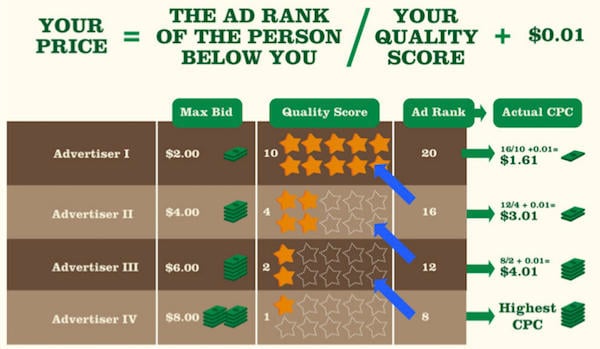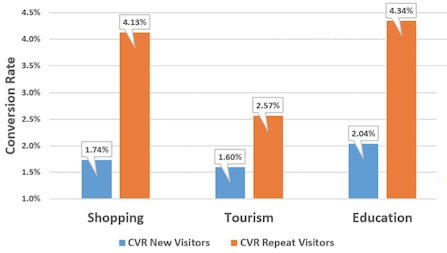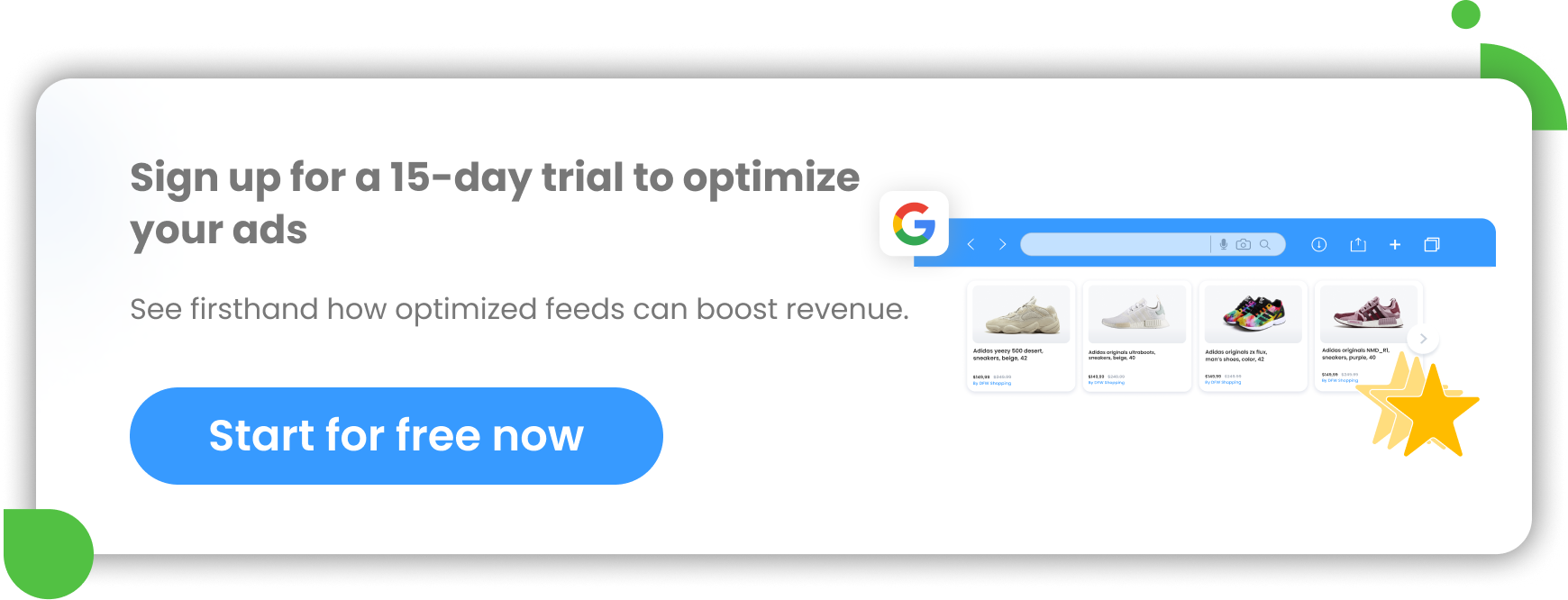Using Remarketing Lists for Search Ads (RLSA) can help you maximise the performance of your overall Google Search campaign strategy. These ads efficiently enable you to target past website visitors, as they are currently browsing on Google and Google’s Search partner websites.
We believe in the saying, "stick with what you know works" - and this is the perfect motivation to roll our RLSA ads across your account! By leveraging them effectively you can increase your conversion rate, cut costs, and more. In this article, we’ve listed 14 advanced RLSA tactics that you can use to improve your overall performance.
In a nutshell, you can use RLSA to:
- Exclude lists (tactic 1)
- Bid differently (tactics 2 - 7)
- Advertise only to the remarketing lists (tactics 8 - 10)
- Monitor brand recognition (tactic 11)
- Remarket based on recency of the interaction (tactic 12)
- Remarket With a supplementary feeder campaign (tactic 13)
- Strategise with your partners & competitors (tactic 14)
What are RLSA?
In Google’s words:
“Remarketing lists for search ads (RLSA) is a feature that lets you customize your search ads campaign for people who have previously visited your site, and tailor your bids and ads to these visitors when they’re searching on Google and search partner sites.”
Usually, marketers would use the Google Display Network for remarketing, however RLSA gives the option to leverage the high intent of Google Search Ads to increase conversions, revenue, and profits.
The users that Google enables us to target are low-hanging fruit in your overall marketing campaign and are a highly valuable audience, who have already interacted with your website and brand, and are therefore very likely to take meaningful ‘converting’ actions with you in the future.
Check: How It Works
Remarketing in general encompasses using a sophisticated tracking code, in order to trace those users who have previously viewed your website (or app). It works by placing cookies on their browsers, and then utilising this information to serve them ads.
When individuals leave your website without buying anything or contacting you, the likelihood is that they will continue to search for your products at a later date. RLSAs enable you to reconnect with these potential customers at a stage when they are browsing for a second or third time.
Google enables us to create tailored ads, set bids, and select specific keywords, whilst bearing in mind that this particular group of customers has already browsed the website. This enables us to tailor offers to encourage a return visit, or re-engage with a customer whom we know what a specific stage of the buying cycle.
Ultimately, RLSAs are a great way to boost ROAS in your account, through targeting a more refined and niche audience who are highly likely to convert on your website.
RLSA from technical perspective:
- It is necessary to have 1,000 cookies to have an active remarketing list.
- It is possible to use Customer Match email address lists for remarketing.
- The membership time limit for these lists is capped at 540 days. The maximum duration of these lists are 540 days. You can’t create a list of users who interacted with your website 541 days ago.
- Maximum bid increase is 900%, maximum bid decrease is 90%, it is possible to exclude the list entirely.
- If a searcher is in two remarketing lists, Google will use the higher bid.
- You can use “observation” or “targeting” as bidding settings.
How To Set Up Your Remarketing List For Search Ads
Update Your Privacy Or Cookie Policy
In order to comply with legal regulations, as with all remarketing types, you must first ensure your website Privacy or Cookie Policy is updated to declare your use of DoubleClick cookies. Google’s helpful guidelines can be found at this URL.
Add The Google Ads Remarketing Code To Your Website
To begin using RLSAs, you need to first create a remarketing list, and add the snippet of code (a ‘remarketing tag’) that you will receive from Google Ads, to your website or app. This needs to be added to every page on your website, and it’s function is to tell Google Ads to include every single visitor within your remarketing list.
Steps
- Log into your Google Ads account
- Head to Tools & Settings > Shared Library

- Select Audiences Manager
- Choose Audience Sources > Google Ads Tag > Set Up Tag
- Select the type of data this source will be collecting
 6. Copy the code that appears in the box so you have it ready to paste onto your website. You also have the option to email the code directly to your web developer.
6. Copy the code that appears in the box so you have it ready to paste onto your website. You also have the option to email the code directly to your web developer.
Once added to your website, these lists can be added to existing campaigns and ad groups. Additionally, ‘custom combination lists’ can be created to target a more specific segment of your website visitors. For example, you can target those who have viewed specific pages on your website. You can also create audiences in GA4 and use them in your shopping campaigns.
14 Strategies for using remarketing lists for search ads
EXCLUDE LISTS
1. Exclude users that are not providing value to save money
There 2 reasons to use exclusions:
1. Your business has one-time buyers.
For example, if you have a subscription based business, it makes sense to exclude existing customers from your search campaigns so you don’t spend more money on them.
Or, if you are running lead generation ads and your lead magnet is a downloadable pdf document. Then you would exclude these visitors from your campaigns as they wouldn’t download the document again.
2. Visitors that have indicated that they are not interested.
For each company the indications can be different. However, if you want to save some money on your ads you should try to identify the visitors that don’t provide value, so you don’t pay for them multiple times.
Here are 2 types visitors to potentially exclude:
- Visitors who immediately bounce
- Visitors who clicked on your ads multiple times but didn’t do a desirable action
BID DIFFERENTLY
2. Bidding higher for returning customers.
In a perfect world, a customer that has bought something on your website would remember your brand and go directly to your website to make another purchase. However, that is not always the case.
What you can do is make a remarketing list of all your existing customers. This is a very high-quality remarketing list and you can bid significantly higher for them.
Here is an example:
A customer bought cat food from your eCommerce store. After a while the same person searches this phrase on Google: “buy cat food online”. There is a very high chance that the person will click on your ad and buy from you again if your ad shows up. Therefore, you should make sure your ad shows on top of Google’s search result page by bidding significantly higher on that remarketing list.
3. Bidding higher at different shopping stages
In eCommerce there are many steps that you can record:
- viewed product
- added to cart
- started checkout
- checkout
You should make a remarketing list for each stage.
Generally, the closer the user is to checkout the higher the bid adjustment should be. It is possible that the same user comes back at the different stages.
Here is an example of bid suggestions:
- Viewed product – +15% adjustment
- Added to cart – +40% adjustment
- Started checkout – +70% adjustment
Keep in mind that you need to evaluate your own data and make bid adjustments that make sense for you.
For SaaS, maybe they signed up for a demo or free trial. You should then make a remarketing list of those visitors and bid higher. Here is an example of bidding higher for users who participated in a trial:

4. Bidding higher for related products or services – upsell.
When a customer buys something you can predict what else that user would buy next to supplement their initial purchase.
Imagine if a customer buys yoga pants on your site. After a while the same customer might search for yoga mats on Google. If you have a remarketing list made for ‘yoga pants purchases’ you can bid significantly more for yoga mats searches when using this list.
Here’s how you would do it:
- Create a remarketing list of ‘yoga pants purchases’
- Add this remarketing list to ad group or campaign where you target ‘yoga mats’
- Increase bid adjustments on this remarketing list (you can also target only this remarketing list – we’ll cover that later)
5. Bid on broader keywords with RLSA
Broader keywords usually have a lot of non-qualified traffic. This impacts conversion rates, and hence, can be unprofitable. Therefore, a lot of advertisers are not bidding on these keywords or have very low bids.
However, amid all that non-qualified traffic there is still good quality traffic which can bring extra conversions.
You can add the RLSA to these ad groups for broader keywords and bid higher on those lists as they’re qualified. Therefore they should increase conversion rates and sales.
The idea is that people who search for this already know your brand so they’re more likely to convert.![]()
6. Bid on less-affordable keywords with RLSA
If your industry is very competitive, there might be some keywords which are simply too expensive for you. Meaning that even if you show up for a certain search term and the user converts, it still won’t be profitable.
However, you can combine these expensive keywords with remarketing lists. Not only will this increase the conversion rate, and hence profitability, but also will cut all unnecessary costs.
Bonus tip: You could drive a lot of cheaper traffic using Facebook Ads and then remarket those users with expensive keywords.![]()
7. Bid on your competitors with RLSA
This tactic is similar to what we went over in tactic 5 with broader keywords.
Most likely the user who visited your website and searches for your competitor is doing some sort of comparison research. Therefore, if you want to be ahead of the competition, you could bid higher on competitors with RLSA.
Additionally, you could write a discount in your ad copy or say why you are a better choice than all of your competitors.
Keep in mind that by bidding on competitors, you can start a bidding war. Meaning that competitors will start bidding on your brand terms as well. Some advertisers create gentlemen agreements between themselves. This means that companies agree not to bid on each other.
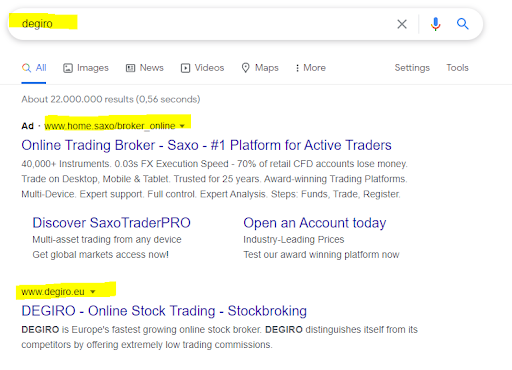
ADVERTISE ONLY TO THE REMARKETING LISTS
8. Advertise low profit-margin products
Not all products and services have the same profit margins. For some, the profit margin is so low that it doesn’t pay off to advertise them.
With RLSA you can start advertising for these products.
You can set up a campaign that ONLY targets your remarketing lists. Choose the highest quality ones – users who made purchases in the past.
Also keep in mind that the list needs at least 1,000 cookies. So if you have a small account try to use longer durations, for example, a list of visitors who purchased in the last 540 days.
Let’s imagine a situation:
The profit margin for selling watch straps is very low, so you decide not to run ads for them. However, you could create a separate campaign – Watch Straps – with relevant search terms, and run the ads ONLY targeting customers who had bought a watch from you.
These customers already know your brand so it is more likely that they will convert.
This way you can save money and still advertise low profit-margin products. Of course, it still might not be profitable as many things can influence it, but it’s a valid tactic to test.![]()
9. Campaign split – targeting only RLSAs vs general
This tactic is similar to how some advertisers structure Facebook ads campaigns – cold traffic campaigns, hot traffic campaigns (remarketing), and look-alike campaigns (not relevant for this topic).
This is how to do it:
- Copy existing campaigns
- Add RLSA to copied search campaigns
- Set Targeting on the ad groups in order to only bid on the lists
- Exclude the lists from existing/cold search campaigns
- Increase bids for the remarketing search campaigns
This gives you the option to better control the traffic and bids. Generally, you would bid higher for remarketing campaigns but also have higher ROAS targets than the cold campaign.
We all know the saying that it is much more expensive to buy new customers than to keep existing ones.![]()
10. Customize ad copy of extended text ads and responsive search ads based on RLSA
There are 2 ways to do it:
Make a separate campaign targeting the remarketing list or make ad customizers like in the image below.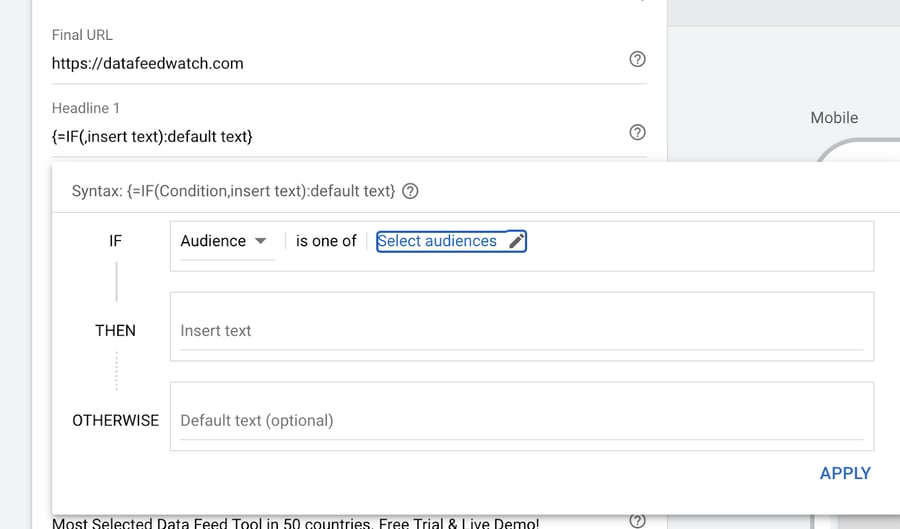
If you have a list of customers who bought a watch and are searching for watch straps, you could write ‘Best straps that goes with x watches’.
Another way could be writing a % discount for users who abandoned their cart.
My suggestion is to be subtle in the customization of your ad copy, otherwise - it might scare the potential visitors away.
Bonus point: Don’t forget that you can tailor not only the ad copies but also landing pages for your remarketing lists. Tailored landing pages are known to increase conversion rates.
You may also find interesting: How to Improve Your Ad Copy to Increase Sales: Best Practices![]()
MONITOR BRAND RECOGNITION
11. Add RLSA to brand ad groups or campaigns
There is a big debate about bidding on your own brand terms. In short, I think that every advertiser should protect its brand term and bid on it. The CPCs are very low anyways (unless you have a generic brand name like ‘shoe store’). But this is a topic for a separate post.
Adding remarketing lists to your brand ad groups or campaigns can help you understand if these are first time visitors or they have been on your website before. It gives you an indication of how well people remember your brand.
This tactic is mainly for analysis as you shouldn’t bid higher here – your brand term should be showing number 1 in the search results page regardless of the remarketing lists.
For SaaS businesses, advertisers would want to exclude existing customers as explained in the tactic above.
For example, it is often that a customer tries to log back in and uses your brand term in their search. These users won’t convert again but will only drive your brand ad spend up.![]()
REMARKET BASED ON RECENCY OF THE INTERACTION
12. Split the same RLSA by different time periods – e.g. last 7 days, last 30 days, last 90 days
We already know that the closer a visitor is to a conversion (viewed product → added to cart → initiated checkout → checkout) the visitor is warmer to convert. The same applies when you look at how many days have passed since the last interaction of the visitor.
Here is what it looks like:
If a visitor abandons their cart during the checkout process and uses Google to conduct a search the next day, they are more likely to convert than if the search is made in 180 days.
This means that you can bid higher on the lists that have had the least amount of days since the last interaction.
Hence, you could split all your lists into different periods. All you need to do is figure out what time periods make sense for your business.
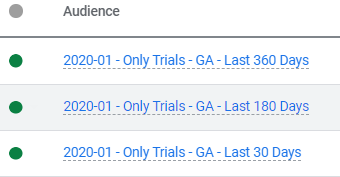
13. ‘Feeder’ Social & Display Campaigns
This strategy advocates combining your RLSAs with separate low-cost audience-boosting social and display campaigns. With a limited budget, or a low search impression share in a competitive market, traditional search ads (without RLSA additions) can be futile and stagnate fairly easily!
This approach suggests ditching these overly competitive campaigns entirely, and using your limited budget to promote firstly only RLSA ads via Google search, and secondly to grow your audience network to drip-feed your remarketing campaigns.
We’ve already established that RLSAs are the low-hanging fruit for your account. The problem with them, however, is that they’re a much smaller audience, and tend to have a low search volume. Therefore, this strategy aims to make the small circle of those familiar with your brand, up to 1000x bigger. This is where cheap social and display campaigns can help.
These low-costing audience growth campaigns generate remarketing lists in a variety of ways:
- Those who engage with your ads via social (click, watch, like etc) are tracked, and can be added into remarketing lists within these platforms directly.
- Those who remember the memorable content from your display ads either:
- a) Do a branded search for your website and products
- b) Complete an un-branded search, but are biased towards clicking on your ads due to their recognition of your company.
14. ‘Partner & Competitor’ Strategies
This final approach looks at the use of Google Search Engine marketing as a whole within your business sector. Ultimately, if you can convince both your partners and competitors to adopt a mutually-beneficial RLSA strategy, this could reduce the cost of your Google Advertising for everyone.
This approach links to the overall manner in which Google auction prices are actually determined. The specific cost per click of an individual keywords is directly proportional and correlates to what the second advertiser is willing to pay.
A highly competitive market-place can therefore increase exponentially in it’s cost-per-click, should a high volume of competitors continually fight to be at the top of the Google results page.
Example:
Imagine luxury car brands, such as BMW, Audi, Porsche, Mercedes etc. These brands are all bidding on the same keywords, presumably along the lines of ‘new sports car, brand new coupe,’ etc. This leads to extremely high CPCs, and lower profitability / sales rates.
If each of these brands were to agree on an overall strategy within the marketplace to only target RLSAs, thereby splitting up the pool of search keywords into their own section, targeting only their respective audiences, bidding would be a LOT more effective. Therefore, ROIs for each individual company would be likely to improve, as CPCs reduce and spend is focused on their specific pool of the marketplace.![]()
RLSA vs Traditional Display Remarketing
Remarketing Lists for Search Ads were an ingenious product introduced by Google in July 2013. They are similar yet different to their predecessor, traditional display remarketing.
Initially the title of the product may be confused with text ads which appear on the Display network. These are an entirely separate product. Ultimately, the only similarity between Display Remarketing and RLSAs, is that both utilise cookies in order to track users, and add them into individually created lists.
Whilst typical Google Display ads deliver advertising to users as they browse on websites within the Google Display network, RSLA ads are specific in that they only appear within search engine results, when the user has actively searched for a term on Google.
Therefore, the user still needs to trigger one of the keywords within your search campaign. In this way, traditional Google Display ads show much more frequently automatically to users in the remarketing lists, whereas RLSA ads have more requirements to be triggered.
| RLSA | Traditional Display Remarketing |
|
|
|
|
|
|
|
|
|
|
Benefits Of Using RLSA
The benefits of utilising RLSA ads is that they ultimately refine your Google Search campaigns in a manner that directs your ad budget specifically into a highly valuable market. RLSA ads are notable for boosting ROAS throughout your Google Ads account. The below highlights the increase in profitability when remarketing lists are added throughout search campaigns:
Conclusion on RLSA
All in all, RLSA is a powerful feature that helps you to optimize bids and be more precise in targeting people on the Search Network. It is especially beneficial for advertisers with tight budgets as it helps to maximize their ad spend.
Now, not all of these tactics will work for you, so don’t blindly go ahead and apply them all. Test them out and see what works well for you. Define what your targets are before you do any bid adjustments and trust data more than your gut feeling – numbers don’t lie.

